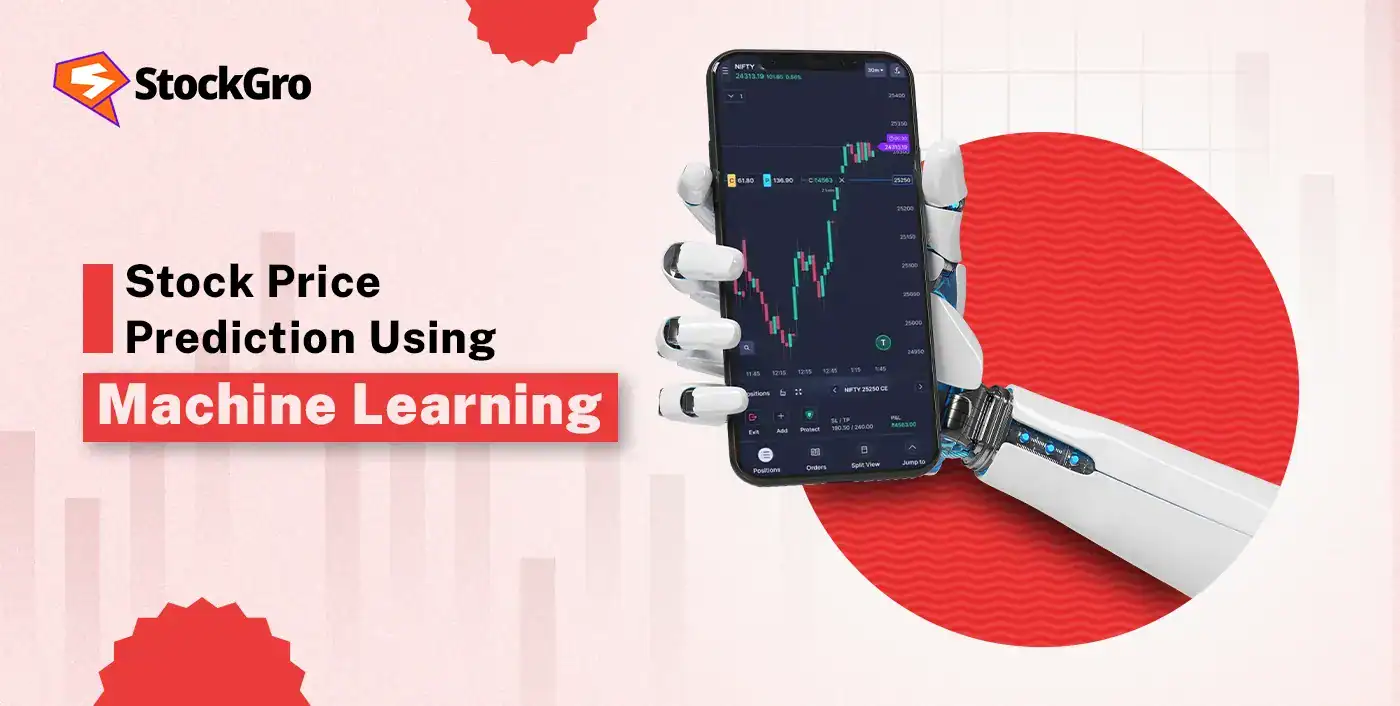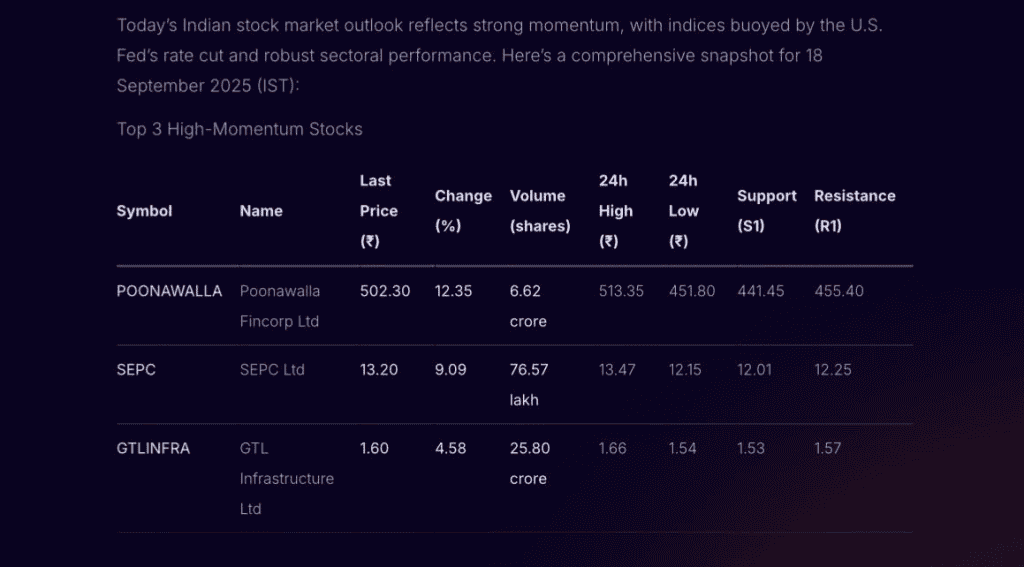
When trades feel more like guesses than strategies, frustration quickly sets in. Watching a stock fall apart after you’ve bought it or suddenly bounce without warning is one of the hardest parts of trading. That’s where stock price prediction using machine learning helps.
By studying past prices, technical signals, and even market news, machine learning turns market noise into useful patterns. In fact, a study found that CNN models achieved up to 98.92% accuracy on historical data, significantly outperforming traditional methods. Clearly showcasing how AI is reshaping market analysis. In this blog, we’ll explain how traders can tap into these models and give traders a sharper edge.
What Is Stock Price Prediction Using Machine Learning?
Stock price prediction using machine learning is the use of advanced algorithms to estimate future price movements by analysing historical and real-time data. Unlike traditional analysis, stock market AI can process massive datasets, including price trends, trading volumes, news, and sentiment, quickly and identify patterns that surpass human capability.
The process works in three stages:
- First, models are trained on past market data to detect recurring signals that often precede price moves.
- Next, their accuracy is validated on fresh data to ensure the predictions are reliable under real conditions.
- Finally, predictions are updated as new information comes in, so the model adjusts instantly to market shifts.
By bringing together depth of analysis, faster updates, and broader insights, stock price prediction using machine learning gives traders stronger guidance on potential price movements, helping them take action with better timing and insight.
Why Machine Learning Matters for Traders
Machine learning has become central to modern trading because it helps uncover signals that are often missed by traditional methods. The main reasons it matters are as follows:
- It can process vast datasets within seconds, combining stock prices, volumes, interest rates, corporate filings, and even social sentiment. This gives traders a panoramic view that would take humans hours or days to compile.
- It improves forecasting accuracy by identifying complex, non-linear relationships in data. For example, an algorithm might connect subtle shifts in currency markets with future movements in banking stocks, patterns that manual analysis could overlook.
- It allows real-time adaptability, with models updating predictions instantly when fresh information arrives, such as central bank policy changes or sudden geopolitical events.
- It strengthens risk management by simulating thousands of potential outcomes, helping traders calculate drawdowns, set realistic stop-loss levels, and diversify positions more effectively.
- It provides behavioural and sentiment insights, analysing unusual trading activity, option chain anomalies, or spikes in retail chatter to detect shifts before they appear on price charts.
- It supports automated execution, where decisions are rule-based and free from emotions, ensuring consistent adherence to strategy even in volatile conditions.
Common ML Approaches (Explained Simply)
Machine learning approaches in trading are simply different ways of teaching algorithms to recognise patterns in stock data and make predictions. Some approaches are traditional and rely only on past price movements, while others are AI-powered and capable of learning from multiple data sources.
When it comes to stock forecasting methods, you’ll see everything from simple statistics to advanced AI stock prediction models. To understand their differences more clearly, let’s break them down through two key comparisons, such as the following:
Traditional vs AI-Driven Stock Prediction Using Machine Learning
Time series vs AI
Time series models have long been the foundation of forecasting, but markets today are far more dynamic. AI-driven models are designed to handle that complexity, making it important to understand how these two differ:
| Aspect | Time series models | AI models |
| Core principle | Assume future prices follow historical patterns | Learn complex, nonlinear relationships in data |
| Inputs | Past prices, trends, seasonality | Prices + indicators, sentiment, macro data, news |
| Adaptability | Rigid; struggle with regime shifts or black swans | Flexible; adapt to changing market conditions |
| Computational needs | Low to moderate | High; require GPUs, big datasets |
| Accuracy | Good in stable, trend-driven markets | Higher accuracy in volatile or complex environments |
| Limitation | Oversimplifies reality; ignores external factors | Can overfit; requires careful training and tuning |
Machine learning vs technical analysis
Technical analysis has been the go-to for traders for decades, but it is often subjective. Machine learning takes a more data-driven route. Comparing the two helps traders see where each excels and how they can complement each other:
| Aspect | Technical analysis | Machine learning |
| Core principle | Price reflects all known information; patterns repeat | Algorithms find hidden patterns beyond human recognition |
| Tools used | Charts, trendlines, RSI, MACD, support/resistance | Regression, classification, clustering, neural networks |
| Data types | Mostly price and volume | Structured + unstructured (e.g. sentiment, news, fundamentals) |
| Accuracy | Depends heavily on trader skill & bias | Higher consistency when trained well |
| Subjectivity | High; interpretation varies trader to trader | Low; outputs are rule-based and replicable |
| Strength | Simple, quick to apply, works in certain market phases | Processes huge data sets, detects weak/hidden signals |
| Limitation | Can give false signals, lagging indicators | Requires quality data, complex infrastructure |
| Example use | Spotting short-term breakouts | Predicting probability of up/down moves with confidence scores |
Benefits of Using AI for Stock Market Predictions
The key benefits of using AI in trading include factors such as:
- Faster data processing: AI can scan millions of data points, price charts, economic indicators, earnings updates, and even news sentiment within seconds, far quicker than human analysts.
- Pattern recognition: Algorithms detect subtle correlations in stock behaviour, like price-volume relationships or repetitive intraday movements, that are often invisible to manual analysis.
- Real-time adaptability: AI models update forecasts as soon as new data arrives, meaning predictions adjust dynamically to reflect evolving market conditions.
- Risk management: By monitoring stop-loss triggers, volatility shifts, and unusual activity, AI helps traders minimise downside exposure before risks escalate.
- Sentiment tracking: Natural language processing (NLP) allows AI to analyse social media chatter, analyst commentary, and financial news to gauge broader market mood.
- Portfolio optimisation: Machine learning can rebalance allocations automatically, suggesting diversification strategies that align with both return goals and risk tolerance.
- Customised insights: Traders receive tailored recommendations based on their preferred timeframes, sectors, or risk profiles, making AI-driven guidance more actionable.
- Backtesting strategies: AI systems can simulate trading ideas on decades of historical data, allowing traders to refine strategies without risking real capital.
Limitations & Risks Traders Should Know
Despite its advantages, using AI and machine learning in trading comes with significant risks, such as:
- Overfitting to historical data
Models that seem accurate using past data often fail in real markets. A 2025 study on high-frequency SPY data found models using technical indicators improved in-sample metrics but performed poorly out of sample, indicating overfitting problems.
- Dependence on data quality
Errors or bias in input data can mislead models. A recent study using FinBERT, GPT-4, and Logistic Regression for stock index prediction found that the simpler Logistic Regression model, with cleaner and more interpretable data, outperformed complex models with noisy inputs by achieving 81.8% accuracy vs much lower for complicated models.
- Sensitivity to external shocks
AI models often fail to predict sudden market shocks. For example, in January 2025, news reports documented Nvidia’s stock plunging nearly $600 billion in market value after the unexpected release of DeepSeek AI’s low-cost, high-performing model which many AI-based trading models did not foresee..
How AI Products using ML Make It Easy for You
Here’s how AI-powered products built on machine learning (ML) make tasks seamless for you:
- Automated data processing: ML algorithms can scan years of historical stock data, quarterly results, and market news within seconds. Instead of manually comparing financials, traders get instant summaries of trends and anomalies.
- Pattern recognition: AI identifies repeating patterns in price charts like breakouts, reversals, or moving average crossovers that many retail investors may overlook. This allows traders to act on signals earlier.
- Real-time alerts: AI tools send timely alerts when unusual price movements, volume spikes, or option activities occur. For instance, a system might notify you if open interest suddenly surges in a stock’s option chain.
- Personalised recommendations: By learning from your trading history and risk profile, ML-driven platforms suggest strategies tailored to your style whether you prefer short-term trades or long-term investing.
- Natural language insights: With AI products that process unstructured data, you can simply type queries like “Show RSI and MACD for Infosys this week” and receive structured analysis instantly.
AI ML Tools For Stock Market Prediction
The rise of AI and machine learning has introduced a new class of tools designed to give traders a competitive edge. In contrast to traditional analysis software, these platforms use complex algorithms to identify patterns, gauge market sentiment, and even generate predictive insights that are invisible to the human eye. Many traders are now exploring free AI tools to get a feel for these advanced capabilities without an initial investment.
For those looking for a dedicated solution, Stoxo AI by StockGro is an AI-powered research engine designed specifically for Indian retail investors. It aims to solve the problem of information overload by providing credible, real-time market intelligence in a simple, conversational format. Instead of just presenting data, Stoxo acts as an investing buddy, helping users decode the market and make confident decisions.
Case Example: How Traders Use AI for Daily Decisions
To understand how traders can seek assistance from AI for daily market decisions, let’s look at an example using Stoxo. After being asked to “Give me today’s stock market outlook with top 3 stocks likely to move, including key support/resistance levels, sentiment from news, and a short prediction for intraday direction,” it provided the following response:

After immediately processing the data, it delivered a comprehensive market summary for September 18, 2025. It identified three high-momentum stocks and provided their main support and resistance levels. Also, it summarised the overall market sentiment.
Future of Stock Prediction with AI
The future of stock prediction with AI is marked by rapid market growth, technological milestones, and promising innovations which include:
- Market growth: The global AI market is estimated at US$244.22 billion in 2025, with forecasts showing a CAGR of 26.60% from 2025-2031, aiming for over US$1.01 trillion volume by 2031. On the other hand, the predictive AI specific to stock markets is projected to expand from $831.5 million in 2024 to $4.1 billion by 2034 at a CAGR of 17.3%
- Quantum computing: Emerging quantum computing technologies promise to accelerate data processing speeds significantly, enabling faster and more complex stock predictions.
- Explainable AI (XAI): By 2027, widespread integration of XAI tools is expected, enabling transparent, interpretable AI models to meet regulatory scrutiny and build greater investor trust.
- Multimodal fusion models: AI systems combining numeric, textual, visual, and alternative data (e.g., satellite imagery, corporate videos) are predicted to become standard by 2030, enhancing contextual awareness and prediction robustness.
- Automation and democratisation: With over 100 million retail investors globally estimated to use AI-assisted trading tools by 2030, AI will democratise predictive analytics beyond institutional circles
Conclusion
The future of trading belongs to those who can apply stock price prediction using machine learning. It doesn’t replace instincts or skills but strengthens them by uncovering hidden connections in data. By combining AI-driven insights with smart risk management, traders can move from reactive decision-makers into proactive strategists ready to steer tomorrow’s markets with precision.
FAQ
AI uses historical data and complex algorithms to identify patterns and trends that humans may miss, offering probabilistic predictions for stock price movements. While AI improves forecasting accuracy, it cannot predict prices with certainty due to market unpredictability and external factors.
Machine learning models can achieve moderate accuracy in predicting short-term price movements or trends by learning from large datasets. However, accuracy depends on data quality, model design, and market conditions, and predictions always involve uncertainty and risk.
Traditional analysis relies on human judgment, technical indicators, and fundamental data interpretation. AI automates pattern recognition, processes vast datasets rapidly, and adapts by learning from changing market behaviour, enhancing speed and complexity beyond traditional manual analysis.
No, many AI trading platforms are user-friendly with graphical interfaces requiring no coding. However, knowledge of data science and programming can help customise models, while most traders can leverage ready-made AI tools without technical skills.
Risks include model overfitting, data bias, false signals, market regime changes, and reliance on historical data that may not predict future events. AI outputs should be combined with human judgment and risk management to avoid losses.
Yes, AI can analyse streaming data, detect real-time patterns, and provide trade signals much faster than humans, aiding intraday decision-making. It enhances speed and responsiveness but requires integration with risk controls and strategy rules.
AI will augment human traders by automating data processing and generating actionable insights but is unlikely to fully replace humans due to the need for judgment, intuition, and adaptability in complex, uncertain markets. Collaboration between humans and AI is the future.

Leave a Comment